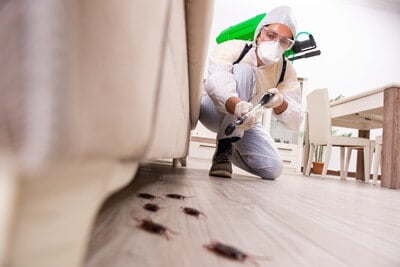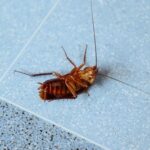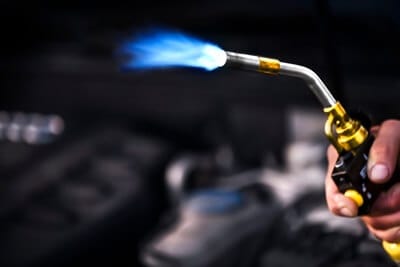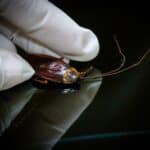Fumigation, also known as tenting, is one of the original methods used for getting rid of cockroaches. It’s primarily used as a last resort against severe infestations.
The chemicals and gasses used in fumigation kill cockroaches and their eggs. It works because the chemicals reach everywhere, even hard-to-reach places. Because these chemicals are so potent, you can’t return to your home until at least 24 hours have passed. It can take up to 7 days for a building to be safe.
Clean thoroughly, remove clutter, and seal up all entry points into your home. You also need to make your living environment as uninviting as possible for cockroaches by cutting off their food and water supply.
Will Fumigation Kill Cockroaches?
Cockroaches are difficult to kill. Scientific Reports explain how cockroaches are developing a resistance to insecticides. Fumigation is an effective pest control method as it kills cockroaches quickly. A lethal chemical is released into a confined area to eliminate large cockroach colonies. It works well because it’s:
- Able to work its way into spaces where cockroaches hide
- Suitable for large buildings and environments
- Fast-acting and rarely requires follow-up treatments
- Effective against all cockroach species
- Kills cockroach eggs (ootheca)
The issue with fumigation is that it can be hazardous to humans and pets, so it should only be used as a method against severe cockroach infestations when you’ve exhausted all other options.
Does Fumigation Kill Cockroach Eggs?
Fumigation is only used in the most extreme circumstances. The gasses and chemicals used during the fumigation process are strong enough to kill cockroach eggs.
Fumigators know where cockroaches hide their eggs. The reality is that killing cockroach eggs is vital as the infestation would continue once the eggs hatch.
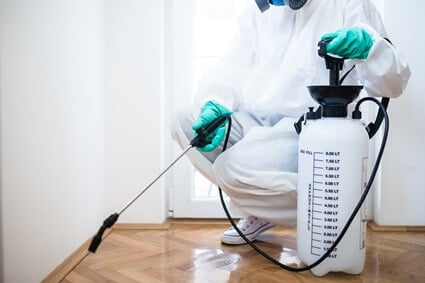
How Long Does It Take for Roaches To Die After Fumigation?
Fumigation is effective, but it doesn’t kill cockroaches immediately. Nobody should enter the property for at least 24-72 hours (or sometimes longer) to allow the toxicity to subside.
During this time, the chemicals will start eradicating the pests. Most cockroaches die 2 weeks after treatment, so don’t worry too much if you see cockroaches once the fumigation’s been carried out.
When you return to your home, take the following steps to prevent cockroaches from being too much of a nuisance while the chemicals get to work:
- Dispose of your garbage and put a lid on the trash
- Seal all cracks, gaps, and crevices to eliminate entry points into your home
- Don’t leave food out on the side and clean up all food and grease spills
- Put used dishes and utensils in your dishwasher or wash them up by hand. Don’t leave dirty items out overnight
- Sweep and mop your floor and vacuum all corners of your home
While fumigation eradicates cockroaches, there’s every chance these pests will come back without the right preventative measures. Keep your home clean at all times and make your home as inhabitable as possible.
Do Roaches Come Back After Fumigation?
Fumigation is one of the most effective methods of cockroach control. It’s used alongside other methods to remove large-scale infestations. Because fumigation utilizes potent chemicals, it’s usually the final stage. Once you’ve fumigated your home or building, the cockroaches are unlikely to return.
That being said, new cockroaches can infest your home if you give them access to the building and provide them with the things they need to survive, such as:
- Food
- Water
- Warmth
- Shelter
Fumigation is only good for existing infestations. If you don’t keep your house clean and there are entry points that cockroaches can squeeze through, you may end up with another cockroach infestation in the future.
When Should You Fumigate for Cockroaches?
Fumigation is a serious cockroach control method, so the decision to go through with it shouldn’t be taken lightly. It’s always sensible to fumigate for cockroaches once an infestation:
- Reaches uncontrollable levels
- Becomes difficult to locate
- Can’t be accessed easily
This happens far more often in unused buildings or large environments with several entry points and an abundance of food and water. This includes the following businesses and industries:
- Shipping and cargo
- Manufacturing
- Warehousing
- Milling
- Agriculture
If you have a cockroach infestation in your home, try to remove cockroaches using less invasive methods first. You may find they’re effective and reduce the need for a complete fumigation.
Dust and bait traps are more suitable for minor cockroach infestations. At the same time, boric acid and diatomaceous earth are better for dealing with a larger colony without too much disruption to your everyday life. Fumigation is an extensive procedure that affects people and pets in the short term.
How Do You Fumigate for Cockroaches?
The fumigation process is extensive and requires thorough planning. You must familiarize yourself with the process at all stages so that you can prepare your home and keep your family and belongings safe. While the methods vary slightly depending on which extermination company you use, these are the main steps:
Before Fumigation
The cockroach fumigation process takes approximately 24 to 48 hours on average to complete, depending on the size of the building and how bad the infestation has gotten. In some circumstances, it may even take as long as one week.
A pest control professional will come to your home to inspect the situation. If it’s severe enough, they will recommend fumigation. There are two types of fumigation methods available, which are to:
- Seal the structure with plastic, tape, or a similar material
- Enclose the structure with a vinyl-coated nylon tarpaulin tent
Before the process can begin, you must remove all plants and pets, including fish, seeds, and bulbs that you plan to plant. You must also remove or seal all medicine, feed, and food in a metal, glass, or resistant container. Your fumigator should provide or recommend sealed plastic bags that will keep your items safe from the chemicals. Once these things are sorted, carry out these steps:
- Thoroughly clean your home by vacuuming and wiping dirt and grime from all surfaces
- Clean your worktops of plates, cups, cooking utensils, and anything else on display
- If you have children, clear away their toys and possessions into sealed boxes
- Move furniture away from walls
- Open cupboard and furniture doors
Your fumigator will then ask you questions about your home’s:
- Construction elements
- Drains
- Conduits
- Vacuum systems
This is to ensure that there’s no chance of the fumigant passing from your home to adjoining structures. Once the fumigator has this information, they’ll be able to start the process.
During Fumigation
Once the fumigation process begins, the home will be sealed, and you won’t be able to enter until it’s over. To ensure no one enters the property before they should, the fumigator will apply a secondary lock that only the company can access on all outside doors. You regain access to your home as soon as it’s safe.
The chemicals used to fumigate are lethal and can kill or injure anyone who isn’t fully equipped and trained to be inside the fumigation zone. Because fumigants are odorless, the fumigator will release a warning agent into the environment at the start and throughout the process.
Once released and circulated, the toxic gasses will penetrate cracks and gaps to kill any hidden away cockroaches. The fumigator will then use large industrial fans to remove the gas from your home once it’s had enough time to get to work, enabling you to move back in safely.
After Fumigation
Once the fumigation’s complete, the fumigator will post a re-entry notice somewhere within the property’s boundaries, alerting that it’s safe for people to enter the home. They will also post a sign in an attic, garage, or other subarea stating the:
- Name of the licensee
- Date of the fumigation
- Fumigant used
This is required by law and must remain permanently attached to make future tenants and homeowners aware of the fumigation that took place. After fumigation, you won’t notice any adverse side effects.
What To Do After Cockroach Fumigation
Once the fumigation process is over, there’s still work to do. You don’t want to do anything that will affect the chemicals that are still killing any surviving cockroaches in your home. That’s why you should avoid cleaning your home for around 5-10 days, or you risk removing residual insecticides.
Removing any chemical residues increases the risk of some cockroaches remaining alive and reinfesting your home. Of course, light cleaning and wiping up spills is okay and actually prevents cockroaches from finding things to eat. As soon as you get back into your home, follow these steps:
- Open all doors and windows to ventilate the environment from lingering fumes
- Maintain a good level of hygiene to minimize the risk of reinfection
- Keep your laundry in zip-lock bags. Cockroaches will eat fabric if nothing else is available
Don’t panic if you still see cockroaches after fumigation. It’s not uncommon for cockroaches to remain a few weeks after the treatment. You may even see them come out during the day because their normal habits have been disrupted. They’ll likely move much slower than usual as the chemicals slowly kill them.
While you may be tempted, don’t use any additional chemicals or treatments on any remaining cockroaches, such as bug bombs or sprays. Doing so may interfere with the fumigation and cause the cockroaches to scatter to new areas of the home. You can manually remove any roaches by picking them up with gloves or paper or vacuuming them up.
How Much Does It Cost to Fumigate for Cockroaches?
Fumigation treatments vary widely depending on the size of the building and how bad the infestation is. However, expect to pay around $1 to $3 on average per square foot. This means a 2,000 square foot home will cost between $2,000 to $6,000 for a complete fumigation.
Similarly, some fumigators charge for tenting the home separately. This can cost anywhere between $1,200 to $3,600 for smaller homes and $2,500 to $7,500 for larger dwellings. However, because tenting is a fundamental part of the fumigation process, many fumigators quote for fumigation and tenting together.
There are also accommodation costs to consider, as you’ll need to stay elsewhere for 2-7 days while the gasses get to work. If you don’t have anywhere to go, you’ll need to pay for a hotel or short-term let.
Although expensive, the long-term damage cockroaches cause can be far greater in the most severe circumstances. Therefore, it’s worth the expense to make your home safe, sanitary, and free from disease-spreading cockroaches.
Should I Be Seeing Baby Cockroaches After a Fumigation?
The cockroaches you’re seeing are the nymphs that have hatched somewhere throughout the process. German cockroaches have a lifespan of approximately 100-200 days, so this isn’t unusual.
Nymphs will eat anything, including dead cockroaches. As soon as they do, they’ll ingest the poison and die soon after. This is all part of the fumigation process.
While fumigation is a disruptive process, it’s worth the time, effort, and expense to get your home back and remove all cockroaches, leaving you with a clean, sanitary living space once again.
